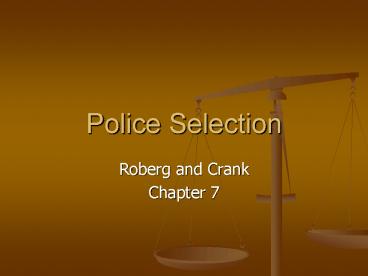Police Selection PowerPoint PPT Presentation
1 / 17
Title: Police Selection
1
Police Selection
- Roberg and Crank
- Chapter 7
2
Selection
- Goal is to hire and develop the highest-quality
personnel available. - Defining quality is difficult
- Intelligence, Physical Characteristics
- Ethics, Higher Education
- Selection process influenced by civil service
rules - Pendleton Civil Service Act 1883
- Enacted to eliminate patronage/spoils system
3
- Three basic selection decisions
- Entry Level
- Reassignment
- Promotion
- Screen out verse Screen in
- Screen out eliminates candidates base on minimum
qualification levels - Screen in identifies only the best qualified
candidates
4
Recruitment
- Several common recruitment methods
- Advertising, Public announcements, appealing to
target groups, referrals, - Portraying the police image
- Sometimes image shown does not reflect reality
- Recruitment strategies
- Different motivators of possible candidates
5
Personal Motivators
- Areas in common
- Helping people and job securities
- Areas specific by gender
- Male crime fighting, excitement
- Female helping people, community problem
solving - Areas specific by race
- Blacks, variety, service to public,
responsibility - Hispanic, variety, service, responsibility and
pay - Asian, responsibility, service, variety
- Caucasians variety, adventure, responibility
6
Non Traditional Recruitment Methods
- Police Cadets
- Community Service Officers CSOs
- Selection enhancements special entry
considerations - College graduates
- Veterans
- Reduction of specific requirements
- Limited fitness testing
- Reduction of education requirements
7
Selection
- Process decides if candidates have the skills and
abilities to perform the job. - Test must be valid, reliable and job related
- Albemarle Paper Company V Moody 1975
- Cannot discriminate base on race, religion,
color, national origin or sex - Griggs v Duke Power Company 1971
- Job relatedness standards upheld by courts
- Davis v City of Dallas 1985 Education standards
8
Selection (cont)
- Bona fide occupational qualification BFOQ
- Job relatedness standards are permissible even
though they may exclude protected groups. - Must be based on a testing or selection method
validated by job analysis - KSAs Knowledge, Skills and Abilities
- KSAs are the standard method in California
9
Pre-Selection Requirements
- Age
- Previous limiting factor, ended by Age
Discrimination in Employment Act 1974 - Some federal entry level requirement still in
place along with state, local maximum retirement
ages - Height and Weight
- Proportional v old standard of strict limits
- Vision
- Correctable, Color Blindness still a limiting
factor - Physical agility and strength
- Must pass job relatedness test
- Suggested alternative no physical testing
10
- Health-based screening
- Some ailments considered presumptive
- Residency
- Must provide reasonable amount of time
- Most Ca. departments removing restrictions
- Education
- Minimum entry standards
- Enhancements to further education
- In service training
11
General Suitability
- Background Investigations
- One of the most critical steps
- Polygraph Examinations
- Voice stress analysis
- Psychological conditions
- Medical conditions
- Cannot be discussed prior to offer of employment
- Drug testing
12
Pre-employment Testing
- Written and cognitive test
- Mostly general knowledge, may be specific to a
job related skill writing ability - Must be objective
- Oral Interviews
- Used by most departments
- Situational and historical questions the most
common. - ADA Limits consideration of a disability until
an offer for employment is made
13
Recruit Training
- Peace Officer Standards and Training POST
- Stressful v Non Stressful training
- Pedagogy
- Art and science of teaching children
- Andragogy
- Art and science of helping adults learn
- Rote memorization v problem solving
- Time consuming process in academy environment
14
Field Training
- Most departments using the FTO San Jose model
developed in late 60s - Field training officers evaluate recruits
performance - Different standards for FTO selection
- Normally a three phase process
- New development is PTO Patrol Training Officer
- Emphasis on training rather than evaluating
15
Additional Training
- In service standards
- Usually at department level to maintain
certifications Ca. 24 hrs minimum every 2 yrs. - Specialized Training
- Investigations, SWAT, Hostage, Undercover, Motors
etc. - Supervisory and Management training
- Minimum requirements per rank
- FBI National Academy/Law Enforcement Command
College.
16
Additional selections
- Assessment centers
- Normally used for promotion process
- Promotional exams may include
- Written exam
- Oral boards
- Assessment centers
- Personnel file review
- Lateral entry officers
- May enter at higher pay grade/rank
17
Academy Training
- Based on Task analysis
- KSAs Knowledge, Skill and Abilities
- Learning Domains
- California POST has 41 individual domains
- Hours vary by academy, but strict minimums are
enforced - Difficulty to keep current in all areas

